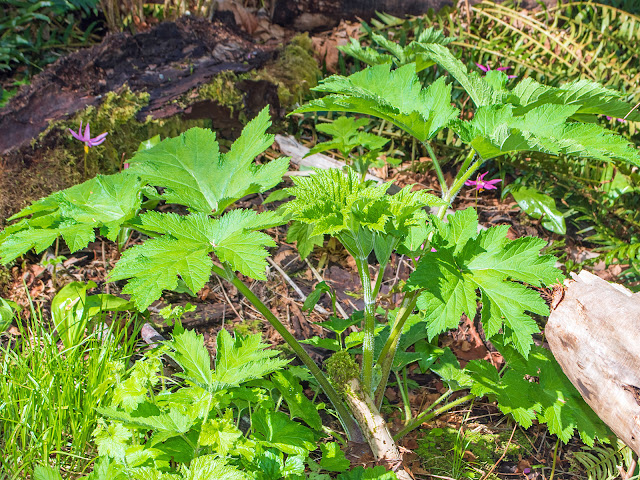I walked this afternoon along the trail beside the Campbell River. It's mostly deep shade, under the shadow of steep banks, covered overhead by tall evergreens. Later, it will be darker; for now, the maples are still leafless, and the forest, under the canopy, is still open. New leaves of budding salmonberry and huckleberry shrubs glow where they catch a ray of sunlight.
And the floor is patterned in pink, white, and green; the first spring flowers are blooming while there is still some sunlight. Pink fawn lilies are everywhere; there are bleeding hearts and trilliums, delicate pink and white slender toothworts, huckleberry buds and salmonberry flowers.
 |
| A mixed patch. |
In this patch I see pink fawn lilies, piggy-back plants, false lily of the valley leaves, cow parsnip, fairy bells, herb robert, evergreen ferns, and one other plant that I should recognize but don't at the moment. Of these, only the fawn lilies are blooming; the others will be along soon.
 |
| Hooker's fairy bells, getting ready to flower. |
 |
| Piggy-back plant, Tolmiea menziesii, in bud. |
 |
| Piggy-backing leaf |
 |
| Cow parsnip leaves. Below, bleeding heart leaves. |
 |
The cow parsnip will be a large plant, overshadowing the earlier-blooming flowers.
|
Tomorrow; trilliums and more pink fawn lilies: there are so many fawn lilies!
~~~~~~~~~~~~~~~~~~~
Caminé esta tarde al lado del rio Campbell. Este terreno está por gran parte del año en la penumbra; el cerro, muy empinado, limita las horas en que le llega el sol, y los árboles de hoja perenne, allá arribe, mantiene todo en sombra. Por ahora, los arces de hoja grande siguen sin hojas, así que dejan penetrar un poco de sol; en el sotobosque las hojitas nuevas de los arbustos de mora de salmón y de huckleberry (arándano rojo) brillan como lucecitas donde les alcanza uno que otro rayo de sol.
Y el suelo lleva un tapete de colores; blanco, verde, y color de rosa. Las primeras flores de la primavera se apuran a salir mientras todavía hay sol. Hay lirios de cervato, color de rosa, por todas partes; están en flor los corazones sangrantes y los trilios, y las tiernas flores de toothwort ("hierba de dientes") en rosa o blanco. Un poco más arriba, se ven las flores de salmonberry y huckleberry.
Fotos:
- Un grupo mixto de plantas: lirio de cervato, Tolmiea menziesii (piggyback plant), lirio del valle falso, pastinaca de vaca, campanas de hada, hierba roberto, helechos perennes, y una planta que debo reconocer pero en el momento se me escapa.
- Campanas de hada,Disporum hookeri.
- Tolmiea menziesii, con botones de las flores.
- Otra, con su hojita nueva de cuestas.
- y 6. pastinaca de vaca, Heracleum lanatum. Éste va a ser una planta grande, dejando los demás en la sombra.
Mañana habrá foto de los trilios. Y más de los lirios de cervato. ¡Hay tantos!


















































